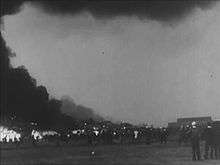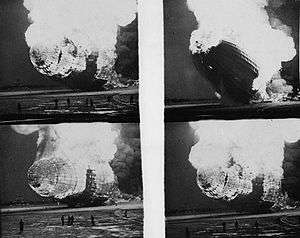Hindenburg disaster newsreel footage

The Hindenburg disaster newsreel footage includes films by several newsreel companies of the Hindenburg disaster where the zeppelin Hindenburg crashed and burned on May 6, 1937.
The film is frequently played with narration by Herbert Morrison, who was there to watch the zeppelin's arrival in the United States. Morrison was a 31-year-old Chicago radio reporter, and his commentary was recorded, and not broadcast until later. It has since been combined with the separately filmed newsreel footage. To modern eyes it may appear to have been a live broadcast with pictures and sound, but it was not. Most of the original newsreels have their own narration, and many composite edits have been made for documentaries.
One common composite found on the internet is a silent film with Pathe footage of the first 1936 landing at Lakehurst and Hearst News of the Day Newsreel footage of the disaster, called a "Pathegram" by Eugene Castle of Castle Films. Another edit popularized on video-sharing sites like YouTube uses footage of the Disaster from Paramount and Movietone Newsreel with Herb Morrison's recording. The Pathe and Universal Newsreels are freely available from government archives.
Four newsreel teams were in attendance at the time of the disaster. They were positioned close to each other and adjacent to the mooring mast for the airship. As a result, the newsreels do not show the mooring mast for the airship to be moored (other mooring masts appear in the background in many of the reels), unlike many of the press photographs which were taken further away which show the mast as well as two of the newsreel cameramen with their cameras mounted atop of newsreel trucks. None of the newsreels captured the initial signs of disaster as the cameras had momentarily stopped filming after the ground crew caught the landing ropes (the fire started approximately four minutes after the first starboard rope was dropped at 7:21). At least one film taken by a spectator is known to exist, showing a side view of the stern on fire and the tail crashing to the ground.
In 1997, the original reels were selected for preservation in the United States National Film Registry as being deemed "culturally, historically, or aesthetically significant."
Newsreels
There are five known newsreels of the fire, released by Pathé News, Paramount News, Movietone News, Hearst News of the Day, and Universal Newsreel (contains the same crash footage as the latter). A fifth reel is of unknown origin.
Pathé

Cameraman William Deeke filmed the scenes in this newsreel. The footage shows the Hindenburg making its final sharp turn to starboard while dropping ballast three times before skidding to port and dropping her landing lines. The narrator describes the Hindenburg as a "puny plaything in the mighty grip of fate", foreshadowing the stern-heaviness and dumping of water ballast as a "grim note of impending tragedy." Deeke had focused the camera on the ground crew before he stopped filming. Although his camera was focused on the airship the moment it caught fire, the camera malfunctioned and it became necessary for him to set up a hand crank, which he only started to use when ship's tail was on the ground and the side collapsed inward. As a result, the Pathe reel is actually the shortest in showing the crash. The footage also suffers from slight camera shake. The newsreel was edited to show the ground crew footage prior to the fire with an explosion sound effect, giving the false impression the ship was exploding while the camera was focused to the ground. Two distinct still frames flash to transition between the ground crew scene and the footage of the fire; these appear to be from footage taken earlier of the ship's landing approach which was edited out of the final reel.[1]
In the early 1990s, some of the footage was colorized and released as part of the series Greatest Headlines of the Century.
Fox Movietone
Filmed by Al Gold (who filmed the fire sequence shown in the newsreel), Larry Kennedy and Deon de Titta. Gold stated that he was filming the ground crew when the fire started. However, the Movietone newsreel shows the ground crewmen catching the ropes early on, and it appears Gold's camera only started to film the fire as the airship's stern touched the ground. Kennedy and de Titta were closer to the airship when the fire started and had to run. Soundman Addison Tice was present as well, and recorded some of the audio of the disaster. Although the explosion sound in the newsreel was simulated, some of the audio may have been from the crash, as someone can be heard saying "you're alright now Al!".
Universal/Hearst News of the Day
The Universal cameraman stationed at the air field left early due to the bad weather and went to see a Broadway play. However, James J. Seeley filmed the disaster for Hearst's News of the Day and Universal used his footage of the fire for their report. Both newsreel companies had taken their own aerial footage of the airship over New York hours before the fire. One scene in the Universal reel showing passengers looking out of the windows, was taken from Universal's 1936 newsreel of one of the Hindenburg's previous transatlantic crossings.
This newsreel is the longest in showing the fire sequence. The camera pans upward showing the stern ablaze as the tail drops down and the nose burns like a blowtorch. It does not show what is happening below the burning airship as it crashes as the camera focuses more on the fire itself until the bow nears the ground. At this point, navy ground crewmen can be seen walking close to the camera.[2]
The Hearst News of the Day Newsreel is much rarer than the Universal reel.[3] A high quality government archive copy of the Universal version also appeared online (which also includes the Universal Newsreel the wreckage a few days after, and the Pathe newsreel). Compared to the Universal edit, the Hearst newsreel has some different shots of the airship over New York and also shows footage of passengers inside the ship from 1936. The same narration is used in the Gaumont British News report which uses footage from both Universal/Hearst and Movietone. Another redub of the newsreel is the "Victoria Record".
Paramount
The Paramount was filmed by Tommy Craven using an Eyemo, which had interchangeable lenses. During the landing approach, Craven alternated between wide-angle and telephoto views of the airship. As the ship dropped its ropes another cameraman can be seen. Craven was using the telephoto lens when the fire started (the footage starts a few seconds after the Hearst reel), giving a close-up view of the fire and people running away from the airship. The footage also shows flames "erasing" the ship's name as it crashes to the ground. Craven, an out-of-work news photographer aspiring to become a newsreel cameraman, was given the chance by Paramount to cover the Hindenburg's landing, which landed him the job at Paramount News. The footage has sometimes been misattributed to Al Mingalone.
Unknown
This footage has been shown in numerous documentaries. It is of poor quality and is rather shaky and filmed from about the same time the Pathé reel started filming. It is possible this footage was taken by a second cameraman for one of the aforementioned newsreel teams. Although it was filmed on the port side of the ship like the other videos, it has often been shown mirrored.[4]
Amateur film
There is an additional known amateur footage of the fire, filmed from the spectator area, giving a side-rear view of the disaster. While it was known by the Lakehurst Historical Society for many years, this footage was not broadcast until May 2014 by NBC, and while missing the initial stages of the fire, it shows the fire a bit earlier than the Universal/Hearst newsreel, seconds before the airship's tail started to fall.[5]
References
- ↑ William Deeke of Pathé News (1937). "Actual Zeppelin Crash!". British Pathé online archive. Archived from the original on 2010-03-17. Retrieved 2010-07-05.
- ↑ "Hindenburg Explodes, Scores Dead - Special Release". YouTube. 1937-05-10. Retrieved 2010-07-05.
- ↑ "First Films Of The Hindenburg Disaster". News of the Day. Retrieved 9 July 2012.
- ↑ "German rigid airship Hindenburg bursts into flames at Lakehurst Naval Air Station in Lakehurst, New Jersey.". Critical Past: HD Video Stock footage. Retrieved 7 June 2016.
- ↑ NBC (2014). "Newly Released Video Shows New Angle of Hindenburg Disaster". NBC News Report. Retrieved 2016-08-13.
External links
- Eugene W. Castle of Castle Films (1937). "Hindenburg Explodes (1937)". Internet Archive. Pathe, Universal Newsreel. Retrieved 2010-07-05.
- Google Patents US1310776
- Hindenburg disaster newsreel footage at the Internet Movie Database
- Hindenburg disaster newsreel footage at AllMovie
- A film clip of the Hindenburg Disaster Newsreel Footage is available at the Internet Archive